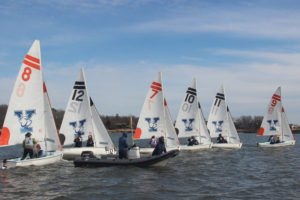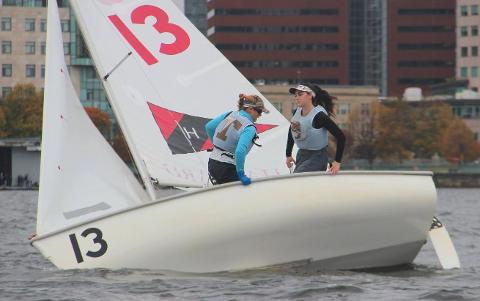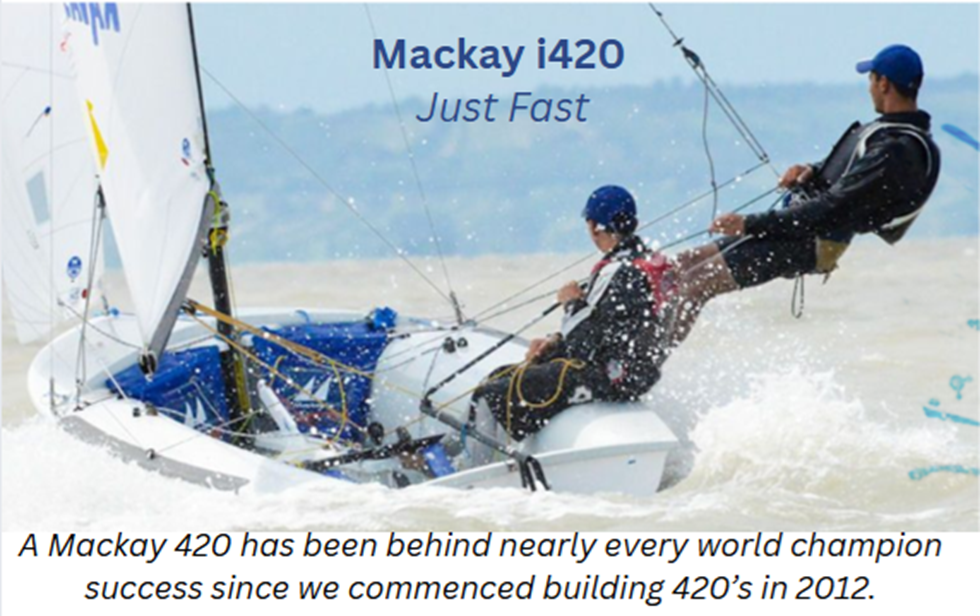
News Flash: Little Washington Sailing School is Hiring! 2 open positions!!
LWSS was founded by sailing enthusiasts to teach kids sailing and appreciate Washington’s marine assets. The club started with a fleet of 14 ft Vanguard 420’s; in 2015 LWSS added 8 ft Opti’s, used world-wide for junior training. The program promotes self-reliance, awareness of safety, sportsmanship, teamwork, self-confidence and respect for others. The curriculum introduces seamanship and the fundamentals of sailing for beginners; a week of advanced sailing is taught at season’s end. The U.S. Sailing Curriculum is used and our instructors are certified by U.S. Sailing.

News Flash: Little Washington Sailing School is Hiring! 2 open positions!!
Blog
S1D ICSA Team Race Rankings, 24 March 2016
March 24, 2016 – Sponsored by Dynamic Dollies, this is the second installment of the 2016 ICSA Team Race Rankings. Panelists include Ken Legler (Tufts University), Ward Cromwell (College of Charleston), Clinton Hayes (Stanford), and Johnny Norfleet (Fordham) and Bill Healy (Yale).
2016 i420 Midwinter Championship Results
2016 International 420 Mid-Winter Championship
|
|
International 420 (27 boats) (top)
Series Standing – 9 races scored
Information is provisional and subject to modification
Regatta results last updated: Sunday, March 06, 2016 1:14:32 PM CDT
Click on race number to view detailed race information.
Pos,Sail, Skipper, Yacht Club, Results, Total Points
1. 55162, Wiley Rogers/Jack Parkin, TCYC/LYC, 1-5-6-6-1-7-4-[14]-1- ; 31
2. 55172, Payton THOMPSON/Victoria Thompson, NHYC/LISOT, [10]-3-1-7-2-5-5-5-5- ; 33
3. 55116, Alex Abate/Marcus Abate, Lakewood Yacht Club, [18]-2-4-1-4-2-10-2-10- ; 35
4. 55917, Dylan Ascencios/Hunter Skinner, Lakewood Yacht Club/ LISOT, 2-6-7-11-8-1-6-3-[28/DNF]- ; 44
5. 55876, Carmen Cowles/Emma Cowles, Larchmont Yacht Club/LISOT, 6-9-9-2-[10]-4-1-10-7- ; 48
6. 55621/55617, Eduardo Mintzias/Katherine Lounsbury, CRYC/LIMA, 3-4-11-5-6-9-2-[28/DNS]-17- ; 57
7. 55570, Emma Kaneti/Catherine Beatrix E. Lindsay, Larchmont Yacht Club, 8-1-5-8-13-8-15-[21]-15- ; 73
8. 55873, Kathryn Hall/Ashton Borcherding, LISOT, 9-15-2-13-18-15-[21]-4-3- ; 79T
9. 55617/55146, Joseph Charles Hermus/Reese Guerriero, Bellport, 12-7-3-10-16-[18]-9-8-14- ; 79T
10. 53629, Timothy DANILEK/Pierce Ornstein, Noroton YC / LISOT, 16-11-10-3-3-13-[18]-15-9- ; 80
11. 55494, Anna-Luisa Brakman/Grace Austin, Noroton Yacht Club / Lisot, 15-16-15-9-11-3-[19]-11-6- ; 86
12. 55912, Emily Haig/Joshua Zeelander, LISOT/Little Egg Harbor Yacht Club, [24]-8-8-4-7-22-12-6-22- ; 89
13. 55147, AnaClare SOLE, Texas Corinthian Yacht Club, [23]-19-19-18-5-11-13-9-2- ; 96
14. 53714/55621, Ivan Shestopalov/Mario Gonzalez, CRYC, [20]-12-14-14-12-14-8-12-13- ; 99
15. 55317, Thomas Rice, LIMA / Seawanhaka Corinthian Yacht Club, 5-18-[22]-12-19-20-3-17-8- ; 102
16. 54069, Dane Byerly/Robbie Nicholls, Lakewood Yacht Club/GCYSA, 17-10-18-16-[21]-16-17-7-12- ; 113
17. 53962, Jack Johansson/Ian Robinson, CRYC, 4-[26]-26-26-24-21-14-1-4- ; 120
18. 53964, Julia Johansson/Isabella Farina, CRYC, 14-17-16-25-9-6-[28/DNF]-22-20- ; 129
19. 56027, John Mastrandrea/Alexandra Tillinghast, American Yacht Club/LISOT, 11-13-12-19-22-24-7-26-[28/DNF]- ; 134
20. 54067, Julia Reynolds/Anne Sidamon-Eristoff, Pequot Yacht Club/LISOT, 19-14-17-[22]-15-10-22-18-21- ; 136T
21. 55341, Eli Burnes/J. Noble Reynoso, Wianno Yacht Club/LISOT, 13-24-25-[27]-17-17-16-13-11- ; 136T
22. 55616, Madeleine Rice/Ariel Casaretto, LIMA / Seawanhaka Corinthian Yacht Club, 7-20-13-17-27-12-20-24-[28/DNF]- ; 140
23. 55988, Sam Gavula/Richard von Waldow, Bay Head YC/LISOT, 21-22-20-15-23-[26]-11-16-19- ; 147
24. 53963, James Paul/Nick Chisari, Stamford YC/LISOT, [26]-21-23-20-25-19-24-19-16- ; 167
25. 55997, Connor Mraz/Rhett Ullmann, Chester YC/LISOT, 25-23-21-24-14-27-[28/OCS]-20-18- ; 172
26. 55296, Teagan Cunningham/Hannah Widmeier, Barnegat Light YC-LISOT, 22-[25]-24-21-20-23-25-25-24- ; 184
27. 55618, Alexandra Mares/GiGi Arias, Houston Yacht Club / GCYSA, [28/DNS]-28/DNS-27-23-26-25-23-23-23- ; 198
Viper 640 Miami Regattas Report & Results
The Viper 640 Class Association
March 16, 2016- The Viper 640 sportboats are just returning from Miami, FL, after sailing two regattas on Biscayne Bay. The first, the EFG Winter Cup (March 6-7), was the final qualifying regatta for the 2015-16 EFG Viper Pan-American Championship, a 12-month series of international qualifying regattas held in Europe, Australia and North America. As in the past, the EFG Viper Pan-Am was sailed as part of Bacardi Miami Sailing Week (March 10-12) sponsored by EFG with each competing boat carrying over qualifier regatta points to be combined with their Bacardi scores.

Crispin’s dominance of the fleet was not totally without its challenges. After the first day of the EFG Winter Cup, Royal Cork Yacht Club’s Anthony O’Leary (former Irish Sailor of the Year) held the lead sailing with his son Robert and Tom Durcan. O’Leary finished second for the EFG Winter Cup with former US Star Olympian John Dane III, Schaeffer Dane, and Dave Bolyard in third. Dane and his crew, while not from across the Pond, are new to the Vipers sailing a boat owned by their home club, Pass Christian Yacht Club in Pass Christian, MS, part of the Gulf Yachting Association.
Day 1 of the Bacardi/Pan-Am racing for the Vipers was cancelled due to high winds but the fleet raced eight races over the final two days in winds in the high teens. Crispin won two of the eight heats, was second twice and third twice. That was good enough to beat Tyler Moore (Hampton Yacht Club, VA) by seven points for the Bacardi Miami Sailing Week title. Moore, sailing with his wife Jane and Tim and Karen Fallon, made a strong finish winning four races—including the final three. Rounding out the top podium spots for Bacardi were Ian Nicholson and David Hitchcock from Britain’s Hayling Island Sailing Club with Australian David Chapman as their third.
After all the sailing was over, it was Crispin who took home both individual regatta wins and the title of 2015-16 EFG Viper Pan-American Champion.
EFG Winter Cup results: http://www.viper640.org/wp-content/uploads/2016/03/VIPER-Winter-Cup-Results-2016-a.pdf
Bacardi Miami Sailing Week results: http://www.yachtscoring.com/event_results_cumulative.cfm?eID=1548
EFG Viper Pan-American Championship results: http://www.viper640.org/wp-content/uploads/2016/03/EFG-Viper-Pan-Am-Scoring-March-2016.pdf
With everyone’s eyes turned to the Viper International Championship and 2015 NAs next November in Bermuda, there was a definite international flare to the Vipers in Miami. In addition to the Crispin and Nicholson UK entries, the O’Leary crew from Ireland, and David Chapman from down under, Mark Griffith, Chris Way, and Mark Haywird traveled from Sydney, Australia, to finish a solid sixth in the Bacardi series. And while Canadian Steve Chapman is a staple for Viper regattas, Bill Abbott, Steve Lacey, and Ched Lee were sailing fellow Sarnia, Ontario, Viperer Brad Boston’s boat in their first Viper regatta. And the US was well represented with crews traveling from California, Texas, Alabama, Mississippi, South Carolina, North Carolina, Virginia, Maryland, Florida, Connecticut, Indiana, New York, and New Jersey.
Next on tap for the Vipers is Charleston Race Week (4/14-17) and Tom Loutrel ([email protected]) and Zeke Horowitz ([email protected]) are managing the process to get more entries. Then, it’s up the coast to the Annapolis NOOD (4/29-5/1). Geoff Ewenson ([email protected]) is driving that effort. Sailors should contact these sailors with any regatta questions.
About the Viper 640
www.viper640.org
The Viper 640 is a high-performance one-design sport boat. At 21 ft (6.40 m) and only 750 lb (340 kg) it combines the stiffness of a keelboat with the acceleration and planing abilities of a dinghy. The Viper has a precise and exhilarating feel on the helm, a spacious cockpit for three or more people, strict one-design class rules and ease of launching by ramp or hoist. With fleets and regattas around the world, there is certainly Viper racing near you.
For more information contact VCA Administrator Ed “Buttons” Padin ([email protected]) or Rondar Raceboats’ Dan Tucker ([email protected]). For more information about the International and North American Championship Regatta contact event chair Doug De Couto ([email protected]) or Royal Bermuda Yacht Club Commodore Somers Kempe ([email protected]).
Women’s Team Racing in NEISA and Elsewhere
By Tufts Head Coach Ken Legler


Bowdoin was paced by the speedsters Erin Mullins/Catherine Price in the rock steady ten knot Southerly sea breeze. They were the only team to knock off Yale and all three of their boats are fast, really fast.

Connecticut had a good team but found a bit of trouble getting into a rhythm when rotating different players in. Unfortunately they are not entered in the Duplin later this month. One of their better women skippers, Charlotte List, was also team racing elsewhere.
Brown was without Megan Grapengeter-Rudnick who, like Yale’s Klingler, was racing for the Brown coed B team. Meanwhile Lindsay Baab, a superstar in Radials, is still figuring out FJ speed. That was particularly noticeable against faster Bowdoin. Give Baab a little more FJ training and watch out.
Dartmouth, Boston College, Vermont and Northeastern will also play at the Duplin in Tufts brand new Turbo Larks. Dartmouth won the women’s AC’s in the fall and should be strong at team racing following spring break with Sarah Williams, Emily Petno, and Peggy Kilvert at the helm. Emma White is another skipper but is also an excellent crew.
Boston College has always enjoyed and done well at the Duplin and they likely will again. Allyson Donahue and Isabella Loosbrock are their lead skippers. Not sure who the third skipper will be but over half of their many female crews are also good skippers.
Vermont, like many women’s teams, has two great skippers but their sizable roster includes more women than men. Megan Yeigh and Amina Brown will lead the way.
Northeastern has not been ranked high in women’s sailing yet but they have players, are improving rapidly, and can start three experienced women skippers; Elise Gehling, Sarah de Silva and Victoria McGruer.
Other good NEISA teams such as Coast Guard, Boston Univ. and Harvard will be focusing entirely on fleet racing this year. Coast Guard in particular could put together a very good women’s team racing squad.
Stanford might have the best women’s team race unit in the nation. With four great skippers, Maeve White, Lily Katz, Julia Lambert, and Martina Sly, along with strong crews including senior Yuki Yoshiyasu; it’s too bad there isn’t a women’s team racing nationals already. Although they cannot make the cross country trip to the Duplin this year, they have in the past and will again. In the meantime they got to enter the McIntyre at home at tied for second. Their coed team won.
I’d like to see a women’s team from George Washington. Mirtanda Bakos and Hannah McNomee skippered to a win at the Fall MAISA women’s champs while India Johnstone alternates as skipper and also does really well.
Georgetown could be team racing with Mary Kate Mezzetti, Rose Edwards and Haddon Hughes at the helm. St. Mary’s College has Carolyn Smith, Greer Watson, and Marissa Golison.

ICSA Team Race Rankings, 3/13/2016





